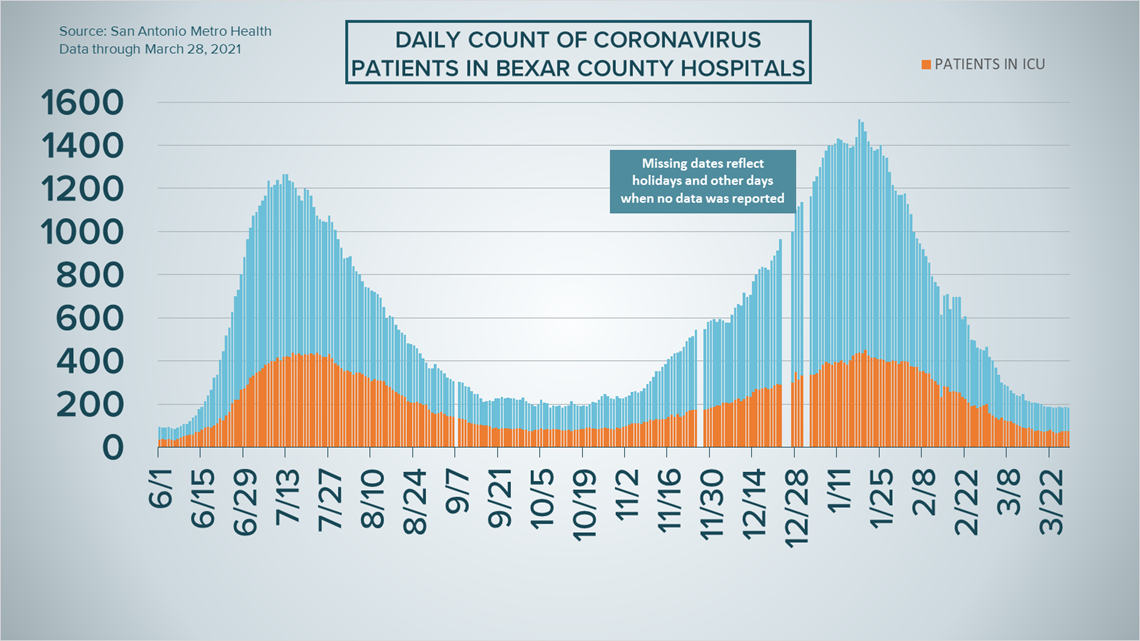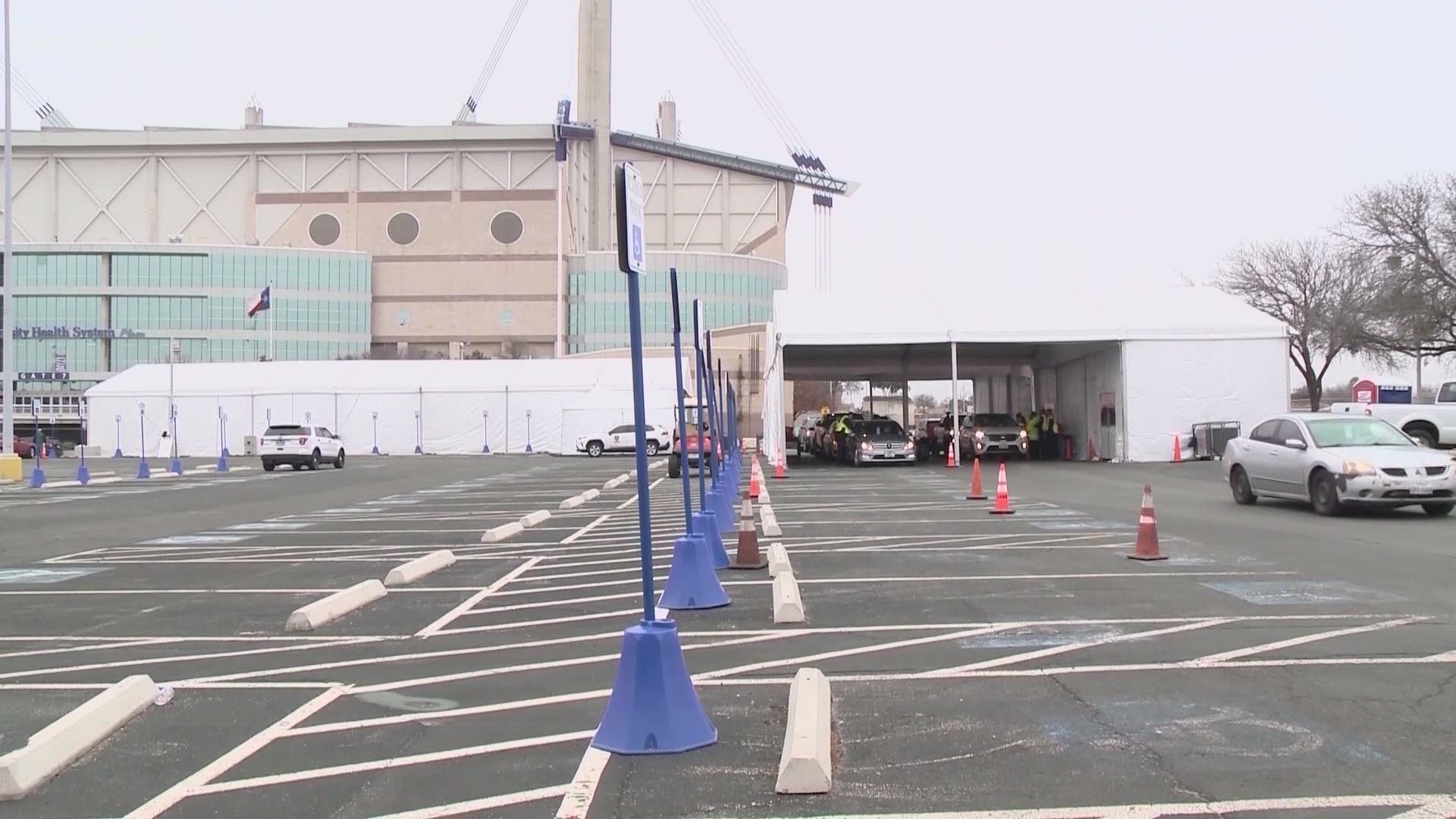SAN ANTONIO — We're tracking the latest numbers from the coronavirus pandemic in San Antonio and across Texas. Here are the latest numbers reported by Bexar and surrounding counties:
- Bexar County: On Sunday, 317 new cases were reported along with a backlog of 1,259, bringing the total number of cases to 205,099. No new deaths were reported, but a backlog of 67 fatalities raised the local death toll from virus complications to 3,144.
- Hays County: On Friday, officials reported 28 new cases in the county and no additional COVID-related fatalities. There is now a total of 17,044 lab-confirmed local cases, while the death toll remained at 236. Officials estimate 16,414 residents have recovered, while 394 are still ill with the virus.
- Comal County: Officials reported seven new cases on Friday, along with no additional virus-related deaths. As of Friday, 9,643 total COVID-19 cases have been reported, including 5,071 confirmed and 4,551 probable cases, while 305 county residents have died due to COVID-19 complications.
More county case information is available through the Texas Department of Health Services COVID-19 dashboard.
How Bexar County is trending
We've tracked how many coronavirus cases have been confirmed in Bexar County from the time officials began reporting cases in March 2020. The graphic below shows the number of cases since June and charts those daily case numbers along a 7-day moving average to provide a more accurate picture of the overall coronavirus case curve in our area and the direction we're trending amid the pandemic.
On Sunday, Metro Health updated its online coronavirus-tracking dashboards to reflect an additional 1,576 cases in Bexar County, bringing the total diagnosis count to 205,099 since the pandemic began. 317 are new cases, while 1,259 were attributed to backlogs.
The seven-day rolling case average jumped from 167 on Saturday to 184 on Sunday.


Health authorities, meanwhile, reported no new virus-related deaths, but a backlog of 67 older deaths. At least 3,144 county residents have died from COVID-19 complications.
Coronavirus hospitalizations have plateaued in Bexar County over the last week, hovering between 182 and 188 for several days (the number dropped by 28 over the prior seven days). On Sunday, the number of concurrent patients receiving treatment at local facilities stood at 182, which is down five from Saturday.
Of those 182 patients, 37 are on ventilators and 74 are in intensive care.


Coronavirus in Texas
The total number of novel coronavirus cases in the state since the pandemic began grew by 2,415 on Sunday, according to the Texas Department of State Health Services. That total includes 1,918 new confirmed cases, 367 new probable cases, and a backlog of 130 cases. More details can be found on this page.
Sunday's figures bring the total number of Texans diagnosed with COVID-19 to more than 2.772 million.


Meanwhile, state health authorities reported an additional 63 deaths from coronavirus complications in Texas. In all, 47,156 Texans have died from COVID-19 complications.
The number of concurrent hospitalizations across the state saw its biggest drop in a week, decreasing by 204 over the past 24 hours to 3,104 COVID-19 patients receiving treatment for their symptoms across the state, as of Sunday. Coronavirus-related hospitalizations have fallen by 45% since the start of March across the Lone Star State, and by 78.2% since the pandemic peak of 14,218 on Jan. 12.
The state, meanwhile, estimates that about 2.621 million Friday have recovered, while 99,685 Texans remain ill with COVID-19.
The latest update from the Texas Education Agency showed that there have been at least 196,560 cumulative cases among staff and students on Texas public school campuses through March 21. That number comprises 128,352 positive student cases and 68,208 staff cases. More information can be found here.
The TEA typically releases new data on school cases on Fridays.
Latest Coronavirus Headlines
- Texas to receive more than one million first doses of the coronavirus vaccine
- Ohio Lt. Gov. Husted posts controversial tweet calling COVID-19 the 'Wuhan Virus'
- Effort to track COVID-19 via wastewater-testing completed, winter results revealed
- Houston woman goes home 162 days after being admitted into the hospital with COVID-19
- San Antonio company recovering after pandemic, winter storm, fire, and robbery
- VERIFY: Yes, FEMA will pay funeral expenses for people who died from COVID-19
- Housing advocates call for federal eviction moratorium to be strengthened
- VERIFY: Are some groups more likely to report vaccine side effects?
Coronavirus symptoms
The symptoms of coronavirus can be similar to the flu or a bad cold. Symptoms include fever or chills, cough, shortness of breath or difficulty breathing, fatigue, muscle or body aches, headache, new loss of taste or smell sore throat, congestion or runny nose, nausea or vomiting, and diarrhea, according to the Centers for Disease Control.
Most healthy people will have mild symptoms. A study of more than 72,000 patients by the Centers for Disease Control in China showed 80 percent of the cases there were mild.
But infections can cause pneumonia, severe acute respiratory syndrome, kidney failure, and even death, according to the World Health Organization. Older people with underlying health conditions are most at risk.
Experts determined there was consistent evidence these conditions increase a person's risk, regardless of age:
- Chronic kidney disease
- COPD (chronic obstructive pulmonary disease)
- Obesity (BMI of 30 or higher)
- Immunocompromised state (weakened immune system) from solid organ transplant
- Serious heart conditions, such as heart failure, coronary artery disease, or cardiomyopathies
- Sickle cell disease
- Type 2 diabetes
- The CDC believes symptoms may appear anywhere from two to 14 days after being exposed.
Human coronaviruses are usually spread...
- Between people who are in close contact with one another (within about 6 feet).
- Through respiratory droplets produced when an infected person coughs, sneezes or talks. These droplets can land in the mouths or noses of people who are nearby or possibly be inhaled into the lungs.
- Some recent studies have suggested that COVID-19 may be spread by people who are not showing symptoms.
Help stop the spread of coronavirus
- Stay home when you are sick.
- Eat and sleep separately from your family members
- Use different utensils and dishes
- Cover your cough or sneeze with your arm, not your hand.
- If you use a tissue, throw it in the trash.
Find a Testing Location
City officials recommend getting a COVID-19 test if you experience fever or chills, cough, shortness of breath or difficulty breathing, fatigue, muscle or body aches, headache, new loss of taste or smell, sore throat, congestion or runny nose, nausea or vomiting, or diarrhea.
Here's a Testing Sites Locator to help you find the testing location closest to you in San Antonio.

